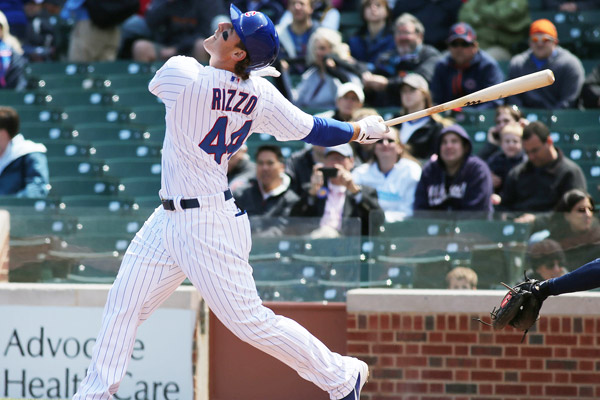
Phil Velasquez/Chicago Tribune
Not long ago, I predicted that the Cubs would lock down Anthony Rizzo for a lot of years and a lot of money, the way they did with frequently brilliant young shortstop Starlin Castro. The club is counting on Rizzo to break the curse—or at least establish himself as a worthy successor to Mark Grace and Derrek Lee.
Sure enough, he just signed for $41 million over seven years, with a rich club option that could continue his tenure with the team into his 30s. This is a 23-year-old, in his first full season in the majors, who just committed to play the rest of the decade in Chicago.
Is he a good investment? He had a rough start to the season, but lately he's been lighting it up, and the trends look good. His on-base percentage is higher than last year's, as is his slugging percentage and isolated power.
But this goes beyond just Rizzo. Contracts like his are becoming a common way of doing business in baseball. The Castro signing signaled the approach to the future for the Cubs, and the majors in general: Teams offer big, long contracts to their youngest stars, taking the risk that barely proven players will continue to develop. A baseball player's theoretical peak is 27 years old, and more broadly between 26-28. Rizzo is signed through his age-30 year, Castro through his age-29 year (with a one-year, $16 million club option).
At thirty, a player begins to decline—and gambling on a rising star is seen as less of a risk than acquiring a costly, proven player, then hoping the decline won't happen soon.
The bad news is, if a player is really good, that decline is more substantial:
From 25 to 30, the two groups lost an average of 10 runs. During the next five years, the run decline was between a 25 to 35. This loss is much more than the average player. (To reiterate: the main reason for the above-average decline is that stars have much further to fall.)
Hall-of-famers don’t usually peak—instead, they plateau. From ages 24 to 30, their production is generally constant. From then on, it drops at a high rate.
Compare this to Alfonso Soriano's career. He got a somewhat late start as a result of beginning his career in Japan, and his first really good season (arguably his best) was 2002, when he was 26 years old, the year after his first full season. He hit 39 home runs and led the league in runs, hits, and stolen bases. He made his first all-star team, and would make the team every year for seven years. But he didn't sign a long-term contract until 2007, which locked him in until age 38.
Soriano was used as trade bait for Alex Rodriguez, whom the Yankees signed to a 10-year, $275 million contract in 2008, his age-32 season. He hasn't played more than 138 games since then. His contract won't expire until he's 41.
The Cubs are embracing this new market, in part because they have to. It's essential to protect the best young players from the free agent market. (As a side effect, that market is becoming a minefield of aging, high-risk players—of the top 10 free agents scheduled to ply their services in the off-season, the youngest is 28-year-old Tim Lincecum, a former ace who's struggled through a couple tough years.)
For years, baseball fans have complained that they're just rooting for laundry, as star players bail for big money on high-priced teams. That's changing. And it gives Cubs fans two gifted, very young players whom they can expect to be around for the rest of the decade.


